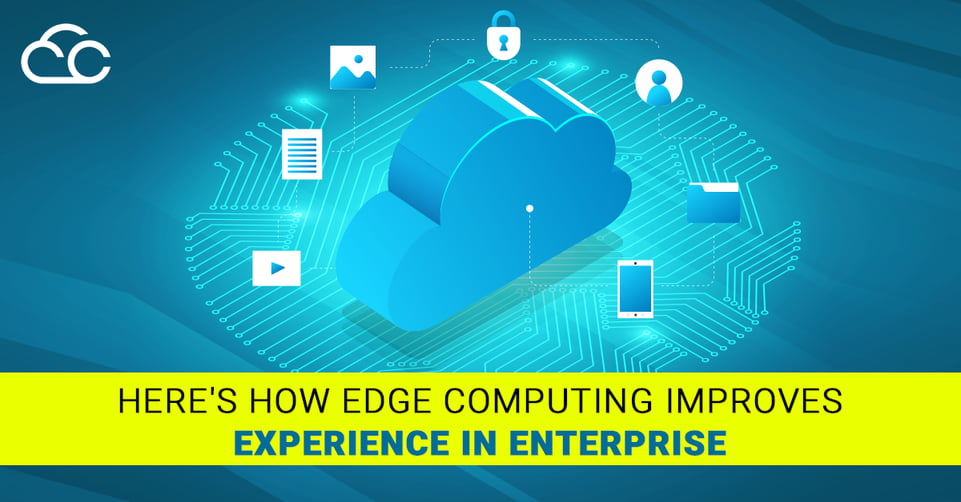Here's How Edge Computing improves Experience in Enterprise

Edge computing is a modern way for businesses to distribute computing resources. It is a relatively recent evolution of computing models. To allow data transmission and service delivery close to the source of data or computing device, edge topology is distributed across multiple devices. This close proximity to the end consumer, whether an employee or a customer using a mobile phone or a store using a point-of-sale device, ensures timely and effective operations. Edge computing is a type of distributed computing in which information processing takes place close to the edge, where things and people generate and ingest data. The trend in computing this century has been to transfer it to the cloud.
In turn, it is similar to the client-server model in that certain tasks are performed closer to the point where the result is needed. However, it varies in that it exists on a modern generation of much more powerful devices, such as mobile phones, that did not exist previously. The ability to reduce latency and bandwidth sparked interest in edge computing. The internet of things and real-time applications, which require instantaneous data processing, are the key drivers today.
What does the term "EDGE" mean in Enterprise?
When it comes to business applications, the word "edge" has a different meaning. It's not about real-time processing here; enterprise resource planning, financial planning and analysis, and human capital management systems don't need it. In the business software environment, edge refers to the method of disseminating bits of a previously monolithic program to its users. Staff do not need access to the entire application suite or all of the company's data. They only need a portion of the application as well as the data needed to carry out their particular purpose.
Giving users just what they need, when and where they need it, decreases response times and increases the user experience. For example, placing a task-specific app with a small data set on the user's own computer would make it easier for them to complete their tasks.
In enterprise applications, there are four distinct types of edge. We may view edge for enterprise applications in four ways:
| The architectural edge refers to the type of system that is being distributed; front-office systems can be distributed at the edge, while systems of record are kept centrally. |
| Geographical edge — A multinational company's systems of record may be located in a cloud in the headquarters region, but subsets of data may be processed in local countries to boost response times or satisfy regulatory requirements. |
| Another type is infrastructure edge where it equates to distributed cloud. Even edge apps will be expected to run in a scalable environment. |
| Instead of forcing a user to access the entire system, with application edge you create task-specific apps in which a small portion of the program is hived off and delivered to the user along with the data they need to complete their task. |
What are the market advantages of doing so?
First and foremost, it enhances the people experience by making the app more user-friendly and homeworker-friendly. It also allows you to take advantage of AI's capabilities and latest innovations. For quick response, workloads like voice recognition must run locally, but the algorithms can be educated in the cloud. Compliance with data retention regulations is often easier to handle with a distributed application architecture. Overall, moving business software components to the edge makes work simpler, quicker, and more precise. It's also a lean, agile strategy that's more easily adaptable to changing conditions.
You'll need the following skills to be able to do it
To begin with, bringing enterprise tech to the edge necessitates a burning desire to boost experience and the willingness to make work simpler by making software simpler for using. To distribute transactions, the enterprise systems would need to provide a microservices architecture with event-driven and message-based processes. Next, you'll need the ability to build front-office applications as separate units inside the microservices architecture, with trust-but-verify relationships to central systems of record.
Further, to ensure that data at the edge and in the center are aligned, you need a foolproof method of maintaining transactional integrity of data fidelity across multiple locations. While hyperscalers can ensure data delivery, separate tools are needed to ensure that data is assembled in the correct order. Edge is critical in enterprise software, but in a slightly different manner than most people think. In turn, it places control in the hands of the individual.
What's the next thing to do?
When it comes to edge computing, every business should ask itself, "Is my data in the correct place?" and then about “What is my edge computing strategy?”
As data volumes increase, more businesses are evaluating where they can store data for the best cost and efficiency. As the Internet of Things (IoT) revolution advances and more devices are connected to the internet, the need for data processing and storage increases exponentially. Click to know more on Enterprise ready cloud and how it can help transcend your business.
